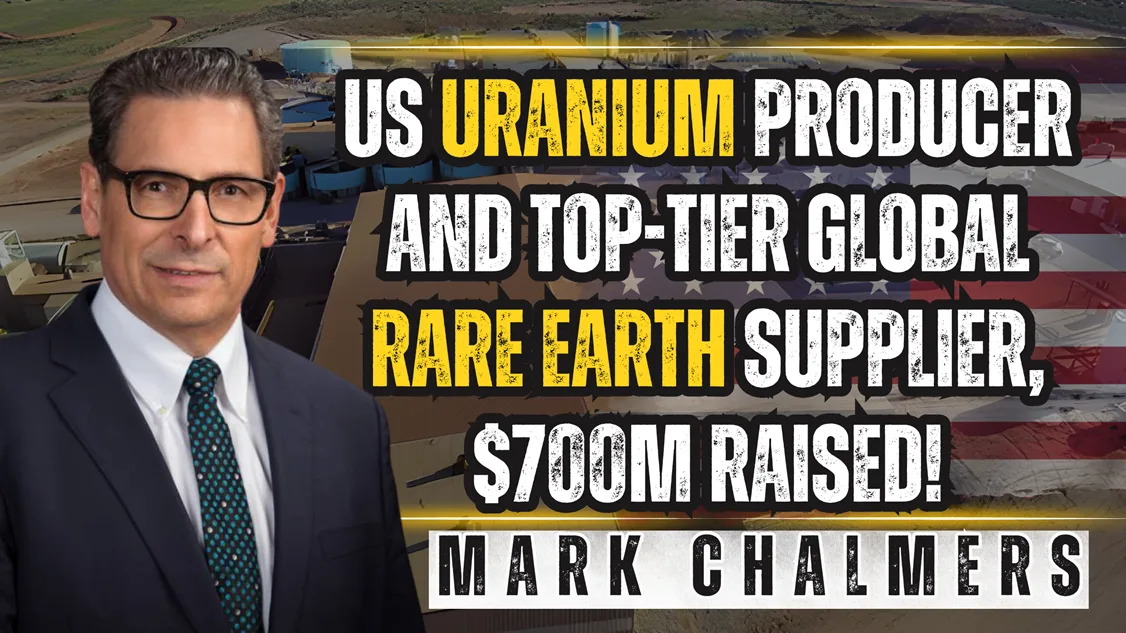
This article is based on the interview with Mark Chalmers. Presented company has paid for the interview creation so this should be considered as sponsored content!
Introduction
In a rapidly evolving landscape of critical minerals, where geopolitical tensions and the global push for clean energy are reshaping markets, Energy Fuels Inc. stands out as a key player in the United States. Led by CEO Mark Chalmers, the company has adopted a unique "uranium core rare earth accelerator" strategy, leveraging its expertise in both uranium production and rare earth elements (REEs) to position itself as a leader in domestic supply chains. This approach has not only weathered criticism but has also driven impressive performance in a volatile sector.
Chalmers provided an in-depth update on the company's operations, market dynamics, and future outlook. With nearly 50 years of experience in the mining industry, Chalmers emphasized the strategic advantages of Energy Fuels' diversified portfolio, highlighting how it mitigates risks and capitalizes on bipartisan support for nuclear energy and critical minerals in the U.S. The discussion covered everything from production ramps and government interactions to rare earth market premiums and international projects, offering investors a comprehensive view of the company's trajectory.
The Dual Exposure Strategy: Shielding Against Volatility and Building a U.S. Critical Minerals Leader
Energy Fuels' dual focus on uranium and rare earths has been a cornerstone of its success, particularly in a year where both commodities have outperformed expectations. Chalmers addressed early critics who questioned the strategy, attributing their skepticism to a lack of understanding of its long-term advantages. "A lot of the critics didn't understand what we're doing, didn't understand the advantages," he noted, pointing to the extended cycles of value drops in these elements.
The strategy's strength lies in its ability to smooth out market volatility. As Chalmers explained, "It seems like one week it'll be rare earth week, and the other week it'll be uranium week." This alternation provides a buffer, ensuring consistent momentum even as individual commodity prices fluctuate. Over the past one to two years, Energy Fuels has outperformed major uranium companies and held its own against rare earth peers, with share price gains reflecting this resilience.
Geopolitically, the timing couldn't be better. With heightened tensions and bipartisan U.S. support for nuclear energy and critical elements, Energy Fuels is positioning itself as a global player with a domestic emphasis. The company's multiple projects span the U.S., Australia, Brazil, and Madagascar, creating a diversified footprint that enhances supply chain security. Chalmers stressed the excitement around nuclear focus, stating, "The focus on nuclear and focus on particularly other critical elements has never looked more exciting." By merging uranium and rare earths, Energy Fuels aims to emerge as a U.S. leader in critical minerals, driving value through scale, low costs, and strategic acceleration.
Leveraging U.S. Government Support: Funding Options and Strategic Autonomy
The U.S. government's pro-nuclear stance and emphasis on securing domestic supplies of uranium and rare earths present significant opportunities for Energy Fuels. Valkovich probed Chalmers on potential applications for programs like Section 45X (advanced manufacturing production credits), Section 48C (qualifying advanced energy project credits), or Department of Energy (DOE) loans.
Chalmers affirmed that the company evaluates all avenues but maintains independence: "We drive our own bus." He highlighted a recent $700 million convertible note issuance with Goldman Sachs at a low 0.75% coupon, demonstrating Energy Fuels' ability to secure attractive financing independently. However, the company remains open to collaborations with the U.S., Australian, or other non-Chinese governments to foster mutually beneficial outcomes.
On the possibility of government equity stakes or direct funding, Chalmers was cautious, avoiding speculation: "I can't speak on behalf of the odds of the U.S. government." He underscored Energy Fuels' status as the largest and lowest-cost uranium producer in the U.S., with substantial assets that set it apart in a sector where many peers struggle with restarts and shortfalls. The company spends considerable time in Washington, D.C., but Chalmers refrained from details to respect governmental processes.
This approach reflects a balanced strategy: capitalizing on policy tailwinds while preserving operational control. As global supply chains face disruptions, Energy Fuels' domestic dominance positions it well for potential support, though Chalmers emphasized self-reliance as the core driver.
Operational Updates: Ramping Up Uranium Production at Key Sites
Turning to current operations, Chalmers provided optimism on sites like the White Mesa Mill and Pinyon Plain Mine. Despite a brief delay in ore transport across the Navajo Nation—now resolved—the company is on track with its full-year production guidance. "We're still ramping up our production... and we're sticking with our guidance at this point in time," he said.
The transition from 1 million to 2 million pounds of annual uranium production is progressing on target and on budget. Mines are performing well, with Pinyon Plain delivering impressive grades. In Q2, averages reached 3.5% U3O8—comparable to top-tier Athabasca deposits—and this trend continued into Q3, though grades naturally fluctuate. These high grades contribute to low costs, projected at $23–$30 per pound for refined U3O8.
Challenges like miner shortages have been minimal for Energy Fuels, thanks to its established technical team. Uranium remains the primary cash generator, funding expansions in rare earths and heavy mineral sands. Looking ahead, 2026 targets include at least 2 million pounds mined, with processing flexibility to align with contracts and spot sales. Chalmers reiterated, "We'll produce more uranium at lower costs than others," positioning Energy Fuels as the U.S.'s top producer for the foreseeable future.
Scaling Production: Pathways to Higher Output and Project Prioritization
If uranium prices exceed $100 per pound, Energy Fuels could scale significantly. Chalmers outlined a path to 5 million pounds annually within four to five years, involving permitting additional projects. Shorter-term ramps could reach 2–3 million pounds faster, building on existing assets.
Prioritized projects include Nichols Ranch (an in-situ recovery operation in Wyoming), Energy Queen (Utah), and Whirlwind Mine (Colorado). Further advancements involve the EZ breccia pipes in Arizona, the large Roca Honda project in New Mexico (under FAST-41 permitting from the Trump administration), and the Bullfrog project. "We can get to the 2 million pounds, potentially up to 2.5 million pounds, without any real new projects," Chalmers noted.
Exploration efforts are underway, with drilling at Nichols Ranch and other properties using one rig to replenish reserves. This measured approach ensures sustainable growth without overextending resources.
Market Dynamics: Utility Contracting and Rare Earth Cash Flow Projections
On utility term contracting, Chalmers observed increasing activity: "There is a market for the utilities to continue to ramp up their term contracting." Energy Fuels holds four existing contracts and is in active discussions for more. He highlighted reliability as a differentiator, noting struggles among newer producers that benefit established players like Energy Fuels.
For rare earths, positive cash flow is anticipated around 2027–2028, contingent on scaling feed supplies. Current limitations stem from insufficient economic-scale material, though supplies from Chemours continue. The Donald project in Australia could provide the next major feed block by 2027. Uranium's immediate revenue stream will bridge the gap, funding rare earth expansions.
Rare Earth Market Evolution and Geopolitical Risks
Chalmers addressed potential Chinese export restrictions, predicting higher premiums for ex-China rare earths. "People are starting to recognize they're going to have to pay more for rare earths that are ex-China," he said. Heavies like dysprosium (Dy) and terbium (Tb) command 2–3 times Chinese prices, while lights like neodymium-praseodymium (NdPr) see smaller but emerging premiums.
This shift underscores the market's evolution toward diversified, secure supplies, aligning with Energy Fuels' strategy to become a top non-Chinese producer.
International Projects: Madagascar Update and Broader Portfolio
The Toliara project in Madagascar faces uncertainty following a recent military coup. Energy Fuels has no active mining operations there yet, and Chalmers described the situation as early-stage: "It's too early to have direct contact with them." Despite this, he remains encouraged, viewing Toliara as a prime economic driver for Madagascar. Appointments in the new regime are promising, but impacts—positive or negative—remain unclear.
Other non-core assets include Brazilian and Australian holdings, with relationships like that with Chemours supporting feed supplies. Uranium spot prices, recently climbing to $81–$81.50, will guide ramps at sites like Pandora, La Sal, and potentially Nichols Ranch restarts.
M&A Strategy: Balancing Uranium and Rare Earth Opportunities
Energy Fuels' mergers and acquisitions (M&A) focus leans toward rare earths for world-scale potential, but uranium deals aren't ruled out if accretive. "If an opportunity arises, we'll look at it based on its merits," Chalmers said. The goal is U.S. significance in uranium (aiming for top producer status) and global top-two or three positioning in ex-China rare earths.
Upcoming News Flow: Milestones for Investors
Investors can anticipate updates on uranium ramps, revenue growth, and declining costs—contrasting with industry trends. Rare earth milestones include feasibility studies for Toliara (this year), Phase 2 mill expansion (aligning with Lynas' scale), and the Donald project. These will detail capital/operating costs, timelines, and compliance, alongside U.S. uranium production news.
Conclusion
Mark Chalmers' interview paints a picture of Energy Fuels as a resilient, forward-thinking leader in critical minerals. By blending uranium's cash-generating prowess with rare earth acceleration, the company navigates volatility, capitalizes on policy support, and builds a secure supply chain. With operational momentum, strategic projects, and a commitment to independence, Energy Fuels is well-equipped for growth in 2026 and beyond. As geopolitical and market forces align, the company's dual strategy positions it not just as a U.S. powerhouse but as a global contender in the quest for sustainable energy and technology resources. Investors should watch for upcoming disclosures, which promise to further illuminate this exciting trajectory.
Watch Mark Chalmers interview here: 
Disclaimer: This article/interview is not a recommendation to buy any shares, products, or services. Always conduct your due diligence and consult with a financial advisor. Presented company has paid for the interview creation!
Sign up to our free monthly newsletter to recieve the latest on our interviews and articles.
By subscribing you agree to receive our newest articles and interviews and agree with our Privacy Policy.
You may unsubscribe at any time.
We use cookies to improve your experience on our site. By using our site, you consent to cookies.
Websites store cookies to enhance functionality and personalise your experience. You can manage your preferences, but blocking some cookies may impact site performance and services.
Essential cookies enable basic functions and are necessary for the proper function of the website.
These cookies are needed for adding comments on this website.
Statistics cookies collect information anonymously. This information helps us understand how visitors use our website.
Google Analytics is a powerful tool that tracks and analyzes website traffic for informed marketing decisions.
Service URL: policies.google.com
You can find more information in our Privacy Policy.